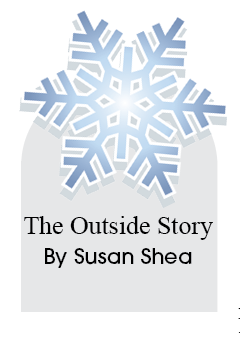
Last February, several evening grosbeaks, which we rarely see here, visited our feeder. About the size of robins, the males were yellow with black and white wings, a black tail, and a bright yellow band above the eyes. The females were silver-gray with tinges of yellow and similar coloration to the males on the wings and tail. Both sexes sport a massive, conical bill — the origin of the name grosbeak — used for extracting and cracking seeds.
A member of the finch family, the evening grosbeak nests primarily in coniferous forests in northern New England and New York, southern Canada, the Rocky Mountains — and as far south as Mexico at high elevations. These birds feed on a wide variety of tree seeds, buds, and small fruits. Conifer and maple seeds, elm and ash buds, and the seeds of chokecherries and apples are among their favorites. Evening grosbeaks st

ore extra food in gular sacs, stretchy areas of the throat. They ingest grit from roads to help digest seeds, and they will break maple twigs in order to drink sap. In summer, these birds feed on insects and insect larvae, especially spruce budworm.
When seed crops fail in their breeding range, or when populations of evening grosbeaks are high, large flocks may fly south or east in winter in search of food, a phenomenon known as an irruption. Chattering flocks or small groups of these highly social and gregarious birds wander about, feeding in forests and at backyard feeders.
Evening grosbeaks are numerous and widespread, but according to the North American Breeding Bird Survey, populations decreased by 74% between 1966 and 2019. Partners in Flight, a global bird conservation network, reports that this species has experienced the steepest population decline of all North American land birds. I’ve noticed this decline first-hand: in the 1990s, evening grosbeaks came to my feeder most winters, but in the past two decades, I’ve only seen them three times.
Population declines may be due to logging and development in the boreal forest, to disease such as West Nile virus, and to reduced numbers of spruce budworm and other forest insects they feed on, partially due to aerial spraying. Forest experts predict that balsam fir will recede from the Northeast over the next century due to climate change, which will likely further impact evening grosbeak populations.
Pine grosbeaks are also occasional winter visitors to the Northeast.
About the same size as the evening grosbeak, this plump finch has a longer tail and a short, curved bill. Males are pinkish-red with a dark gray tail and wings, marked by two white wingbars. Females are light gray with olive-green heads and similar coloration to the males on wings and tails.

Pine grosbeaks breed farther north than the evening grosbeak, up into northern Canada and Alaska. They are circumpolar in distribution, ranging across northern Europe and Asia.
Body size and color vary geographically. In North America, these grosbeaks nest in open coniferous forests across most of Canada and in high-elevation forests of the Rockies.In winter, pine grosbeaks may stay in their breeding habitat or move to nearby low-elevation deciduous forests with abundant seeds.
Like evening grosbeaks, in years when food is scarce, they may fly south or east. Pine grosbeaks sometimes travel to take advantage of plentiful mast crops, even when adequate food is available in their breeding range.
A 2023 study in Sweden by Svein Dale found that irruptions of these grosbeaks coincided with peaks in rowanberry crops: flocks moved south to feed on this fruit and then returned north in mid-winter when the food was gone.
The few times I’ve observed pine grosbeaks, I’ve seen small groups feeding on crab apples or cherries in ornamental trees near buildings. Their diet is predominantly vegetarian: seeds, fruit, and buds. Strong, stubby bills easily crush seeds and nip off buds. Flocks often stay near a tree with abundant fruit until it is all consumed.

In summer, pine grosbeaks catch insects and spiders, especially to feed to their young.
Pine grosbeaks seem to fare better than evening grosbeaks. According to the North American Breeding Bird Survey, their populations held steady between 1966 and 2019, and Partners in Flight ranks this species as low conservation concern.
Evening grosbeaks have been sighted in Vermont and New Hampshire this year, particularly in the Upper Valley, so keep your eye out for these colorful winter finches.
Susan Shea is a naturalist, writer, and conservationist based in Vermont. Illustration by Adelaide Murphy Tyrol. The Outside Story is assigned and edited by Northern Woodlands magazine and sponsored by the Wellborn Ecology Fund of the New Hampshire Charitable Foundation: nhcf.org.




